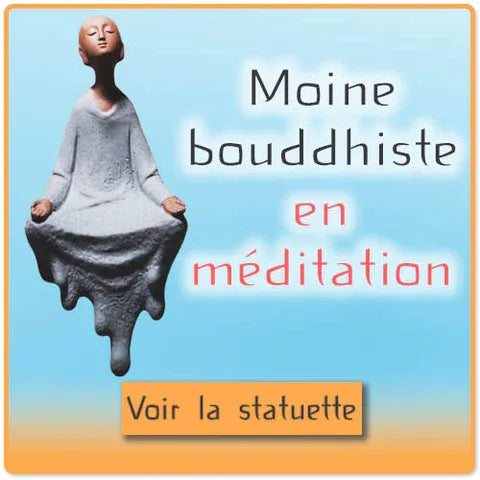A short guide to meditation for sleep

If you have trouble sleeping at night, you might find meditation helpful. Mindful breathing meditation is a deep relaxation technique that will not only make it easier to fall asleep and stay asleep, but will also improve the quality and duration of your sleep.
In this article, we discuss a meditation method rooted in Buddhism that can help you find the peace you deserve at night. By identifying the source of your insomnia, and with the help of a simple yet effective technique, you can regain control of your sleep.
See our collection of Buddhist statues
Many people who practice meditation right before bed find that the quality of their sleep greatly improves. In the morning, they feel refreshed, alert, and more attentive.

What is the best meditation for sleeping?
It's no secret that there are dozens of types of meditation. Here, we'll be discussing a form of meditation based on conscious breathing .
This simple and effective method of meditation for sleep will simply require you to pay attention to your body and your breathing, nothing more.
It has been proven that the less cognitive effort (intellectual activity) meditation requires, the more effective it is at relaxing your mind and body, thus promoting sleep.
All forms of meditation offer numerous benefits, but when it comes to sleep, choose one that helps calm your mind, not stimulate it. Since you're looking for a meditation practice that will help you sleep, you should avoid any practice based on visualization and imagination, as these tend to excite and activate the mind—the opposite of what you want. Over time, you'll learn to calm your mind so that sleep comes naturally.

Is meditation effective for sleep?
With the growing popularity of Buddhism, yoga, and mindfulness , more and more people in the Western world are turning to meditation for sleep to improve not only their ability to relax, but also the quality of their sleep.
Lack of sleep not only harms your productivity, but also your health and longevity by increasing the risk of suffering from stress , anxiety disorders, burnout, diabetes, high blood pressure, obesity and heart problems such as heart attacks and strokes.
Today, more and more doctors recommend meditating before bed , and most patients have noticed a significant improvement in their ability to sleep better and more deeply, without waking up in the middle of the night. It has also been scientifically proven that the practice of calming the mind, which focuses on breathing and mindfulness, reduces fatigue, anxiety, and depression, and reconnects the brain. Meditation is an excellent tool for those seeking a completely natural, drug-free way to treat insomnia . It has also been shown to reduce or eliminate the use of sleeping pills and their undesirable side effects.
The heart of mindfulness meditation is learning to slowly detach oneself from potentially disturbing emotions and thoughts.

How does meditation help with sleep?
To understand how meditation helps with sleep, we must first understand the cause of our insomnia . In rare cases, the source of sleep difficulties is physical and may be caused by illness or other physical ailments. In the vast majority of cases, however, insomnia originates from "monkey mind ." "Monkey mind" is a Chinese Buddhist term, originating in India, that signifies mental restlessness, lack of focus, distraction, scattered thoughts, fatigue, and stress.
As a precursor of psychology, Buddha spoke more than 2,500 years ago about the monkey mind— that restless, agitated, overthinking mind . The monkey mind is the part of the mind that is hyperactive, inattentive, preoccupied, and jumps from one thought to another. This constant noise, created by our monkey mind, prevents us from being present and living in the moment.
This inner monologue is mostly composed of thoughts about life's fears and anxieties. You know the pattern: you start thinking about your bills, your job, the kids, your grocery list, the future, and so on. This overwhelming flood of thoughts prevents restful sleep. This unbalanced state of mind creates a huge amount of stress in our bodies, leading to difficulty falling asleep and staying asleep.
To calm the body for sleep, we inevitably need to work on our mind, and paradoxically, the best way to calm our mind is through the body, through correct and mindful breathing. By focusing on your breath , you learn to quiet the "monkey mind" and release the tensions you've created yourself that manifest in your body.

How to meditate for sleep?
Sleep meditation is a practice that helps you achieve restful sleep by using mindful breathing, as breath is the link between body and mind. Not only will mindful breathing help you sleep deeply, but it will also allow you to feel calmer and more serene throughout the day.
Sleep meditation involves focusing your attention on your breath and the present moment, without getting lost in worries about the past or future. By calming your mind and the flow of thoughts, your body will also calm down, and in this state of serenity, you will be able to fall asleep naturally and easily.

1 - Predispositions
What you do before going to bed (or meditating) has a significant impact on the quality of your sleep/meditation, as well as your ability to fall asleep. Having a relaxing routine at least two hours before bedtime will help reduce stress and anxiety, both mental and physical. In other words, prepare your body for meditation and sleep.
Here are some suggestions you can include in your pre-sleep/meditation routine.
- Dim the lights , create a visually relaxing atmosphere.
- Avoid activities that may cause excitement : phone, tablet, computer or television.
- Engage in calming activities such as listening to music or reading a book.
- Take a hot shower or bath .
- Have a cup of tea or hot milk (avoid caffeinated drinks).
- Avoid thinking about your to-do list for tomorrow .
- Spend time getting closer to your spouse , children, or partner.

2 - Environment
Ideally, you should practice sleep meditation in the same room where you will sleep so you can transition directly from meditation to sleep. Make sure the environment in which you will meditate/sleep is suitable. It goes without saying, but the room should be quiet and peaceful , where you won't be disturbed. The room temperature should be neither too hot nor too cold. Also, ensure the room is dark.

3 - Postures
There are many ways to practice meditation for sleep, and to be honest, the posture you adopt is entirely up to you. You can choose the posture that suits you best :
- On a meditation cushion.
- On a meditation bench.
- On a chair.
- On your sofa.
- In bed.
Close your eyes, remain as still as possible, and become attentive, aware of your body. Feel each part of your body, noticing the touch and pressure where it comes into contact with the seat, the floor, or the bed. For a few minutes, shift your attention to whichever part of your body you wish . By focusing on your body, you avoid overthinking and clinging to your monkey mind.

4 - Breathing
To establish a deep connection between your body and mind, breathe with a calm, long, and deep natural rhythm . You should slightly "pull out" your exhalation as you inhale naturally, but don't overdo it; remain natural. After a minute or two, you should find a breathing rhythm that feels right for you.
Now, you must remain fully present during each of your inhales and exhales. Feel the air entering your nose, your mouth, your throat, and your lungs. During the exhale, feel it leaving your body. Be attentive, present, aware of all of this. Remember, focus solely on your breathing .
5 - State of mind
During sleep meditation, your mind will likely begin to wander , and that's perfectly normal. Don't get upset or punish yourself; simply bring your attention back to your breath. It's entirely normal for thoughts and emotions to arise during meditation.
The goal is to be present , so don't chase or fight your thoughts. The more you try to get rid of them, the more attention you give them, and the stronger they become. Try not to cling to them or identify with them; simply let them pass without judgment, like clouds moving across the sky.
As soon as you realize that you are identifying with or clinging to your thoughts, quickly bring your attention back to your body and your breathing; your mind will quickly calm down .
With practice, you'll experience fewer and fewer intrusive thoughts during meditation, your mind will settle more easily, and you'll fall asleep faster . After practicing sleep meditation for a while, your mind and body will become conditioned, and you'll be amazed at how quickly you can relax. You probably won't need to meditate at all to fall asleep.

Summary of the sleep meditation
- Do relaxing activities two hours before meditation/sleep.
- Go to a quiet place , to a room with dim lighting.
- Choose the posture that suits you ; focus your attention on your body.
- Focus on your breathing and only on your breathing.
- Be present. Don't identify with or cling to the thoughts that arise; simply bring your attention back to your breathing .
Alternative methods: guided meditation
Sleep meditation can be difficult for some people, but anyone can learn to do it. You should develop the ability to meditate without any support. Practicing sleep meditation "on your own" is the best way to truly understand your mind and how it works.
That said, if you've tried meditating for sleep without achieving satisfactory results, guided meditation can help. You can use guided sleep meditation as a stepping stone to learning to meditate on your own, without any support—as it should be.
To help you, you can listen to Mike Meditation, who will soothe you with his lovely voice in this video .
Conclusion
Meditation for sleep is a beautiful way to silence the voices of fear, anxiety, worry, and other negative emotions that take up too much space in your head and prevent you from sleeping peacefully.
Learning to manage your "monkey mind" through conscious breathing is undoubtedly one of the best ways to transform your anxieties into serenity. It may be difficult at first—like most new things—but you'll get there eventually, so don't give up .
By learning the art of letting go , by training your mind, you will not only obtain immense benefits in terms of sleep, but it will also help you to live a healthier and happier life.
Sleep well!

About the author: Elara Vey
Passionate about ancestral traditions and well-being practices, Elara shares her discoveries for Kaosix to help you integrate more harmony and meaning into your daily life.
Discover her journey →
